Learn the best back exercises for training your entire back, get a full back workout, and more!
The post The 12 Best Compound Back Exercises for a Full Back Workout appeared first on Legion Athletics.
Building a great back is freaking hard.
The back is made up of a variety of small, stubborn muscles that often don’t feel like they’re doing much during your back workouts and take their sweet time to grow.
Thus, it’s no wonder that so many people are interested in finding the best back exercises.
Now for the good news: the best back exercises all have a few things in common, and if you do these exercises consistently, you will build a bigger, stronger back in just a few months’ time.
Specifically, you want to focus on what are called compound back exercises.
These are kinds of free weight back exercises that give you a full back workout in less time than other back exercises, and allow you to lift heavier weights more safely.
In this article, you’ll learn the 12 best compound back exercises and my top 3 tips for better back workouts.
[h=2]The Anatomy of the Back Muscles[/h]There are several muscles that make up the bulk of the back:
Here’s how they look:
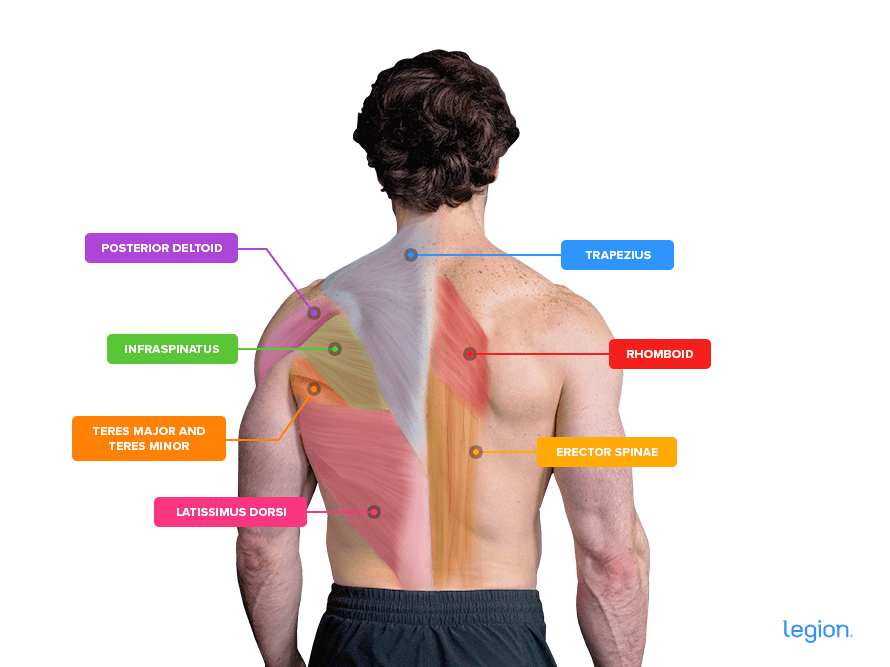
Now, if you’re like me, your ultimate goal for your back looks like this:
Success! Your coupon is on the way. Keep an eye on that inbox!
Looks like you're already subscribed!
[h=2]My Top 3 Back Exercise Tips[/h]Before we get into what the best back exercises are, here are a few tips to help you get the most out of your back training.
[h=3]Use compound back exercises to train all of your major back muscles.[/h]Compound exercises are exercises that involve multiple joints and muscle groups at once.
Consequently, they enable you to move more weight than exercises that train just one muscle at a time, and thus are better for progressively overloading your muscles. They also train a variety of muscle groups at once, giving you more muscle-building bang for your buck than other exercises.
The best compound back exercises you can do include exercises like the deadlift, barbell and dumbbell row, and pull-up and chin-up.
[h=3]Use heavy weights for your back exercises.[/h]As a natural weightlifter, your number one goal should be getting stronger.
So long as you make that your primary focus in your training, you’ll have no trouble with building a big back.
What’s the best way to get stronger?
Lift heavy and get progressively stronger.
By “heavy,” I mean doing back exercises with weights in the range of 75 to 85% of your one-rep max (1RM), or in the range of 8 to 10 (~75%) to 4 to 6 (~85%) reps.
You don’t have to do your full back workout in a low rep range—high-rep sets also have a place—but the majority of your time should be spent doing free weight back exercises with heavy weights.
And by “get progressively stronger,” I mean you should be adding weight to the bar (or dumbbells) over time.
[h=3]Do 10 to 20 sets for your back per week.[/h]This is enough for most people to maximize the growth of their back muscles.
You can make progress by doing less than this, but you’re also probably leaving gains on the table. Do more than this, and you might make slightly faster progress, but run a higher risk of burnout and injury.
You can try to fit all of these sets into a single workout per week (a typical body part split), but it’s generally best to spread them across at least two or three workouts. This prevents you from becoming overly fatigued and having to use lighter weights (see tip #2!).
I’ve found that doing one dedicated full back workout and including a few back exercises in other workouts throughout the week (such as chin-ups on arm day) tends to work best.
[h=2]The 12 Best Back Exercises[/h]As we’ve already said, the best exercises for strengthening and developing your back are compound back exercises that allow you to lift heavy weight safely. This is true no matter what your goals are, which is why the best back exercises for men are the same as the best back exercises for women.
[h=2]1. Barbell Deadlift[/h]
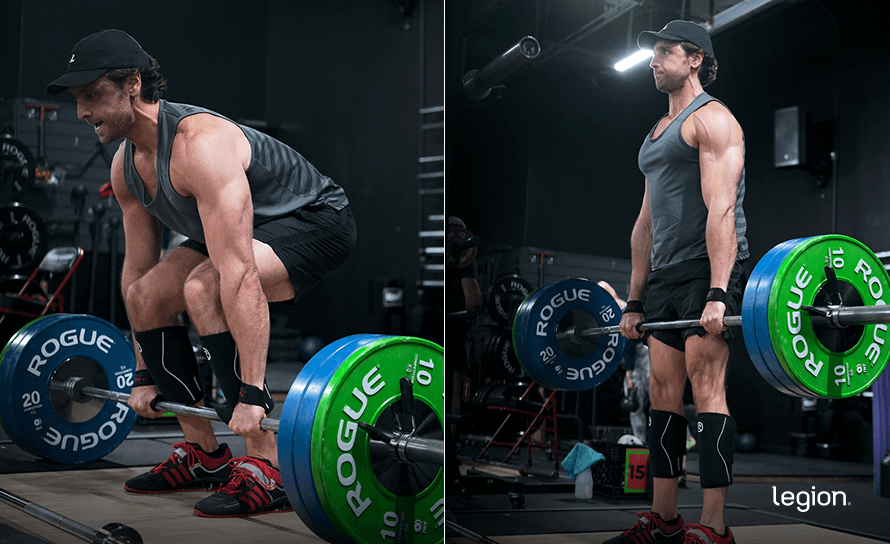
How to: Position your feet so they’re slightly narrower than shoulder-width apart with your toes pointed slightly out. Move a loaded barbell over your midfoot so it’s about an inch from your shins.
Take a deep breath into your belly, then move down toward the bar by pushing your hips back. Place your hands on the bar just outside your shins and keep your head in a neutral position. Drive your body upward and slightly back by pushing through your heels. As you approach the lockout, push your hips into the bar.
Reverse the movement to return to the starting position.
Why: The deadlift is hands down the best all-around back exercise you can do because it trains every muscle in your posterior chain (the muscles on the back side of your body). It also allows you to use some of the heaviest weights in any of your workouts, which means it’s ideal for gaining strength and muscle.
[h=2]2. Trap-Bar Deadlift[/h]
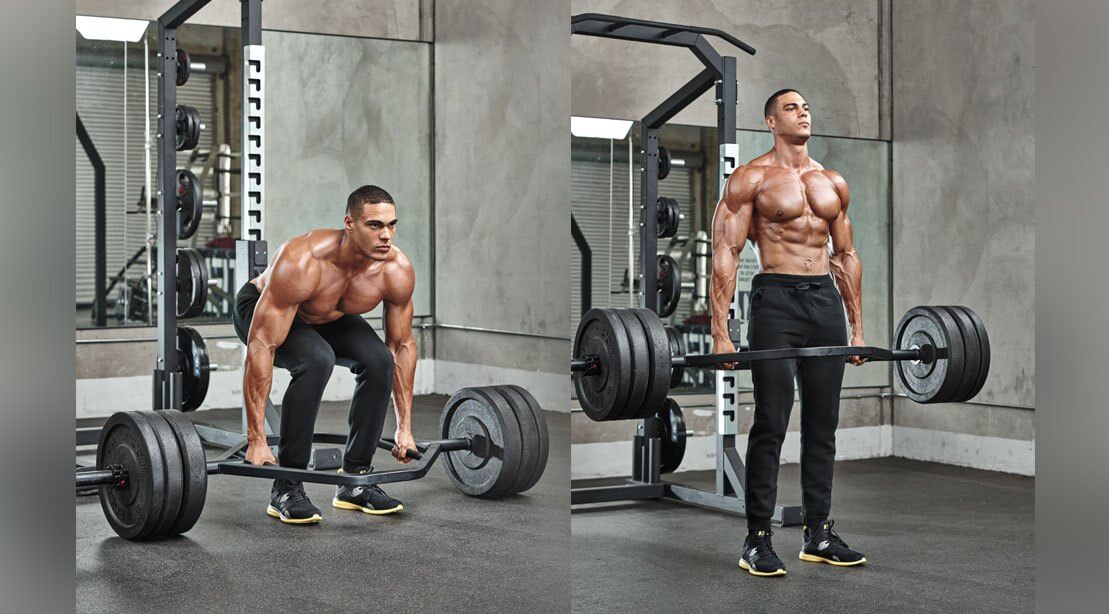
How to: Position your feet about shoulder-width apart inside the rectangular center of the trap bar, and adjust your foot position so that when you tug on the bar it moves straight up, not backward or forward. Take a deep breath and flex your abs. Push your hips back, arch your lower back slightly, keep your shoulders back and down, and make sure your head is in a neutral position.
Drive your body upward and slightly back by pushing through your heels. As the bar passes your knees, push your hips forward. Reverse the movement to return to the starting position.
Why: For many people, the trap-bar deadlift is more comfortable and easier to learn than the conventional deadlift. It also allows you to lift around 5 to 10% more weight than you can with the barbell deadlift, and it may be slightly better for improving athletic performance.
[h=2]3. Sumo Deadlift[/h]
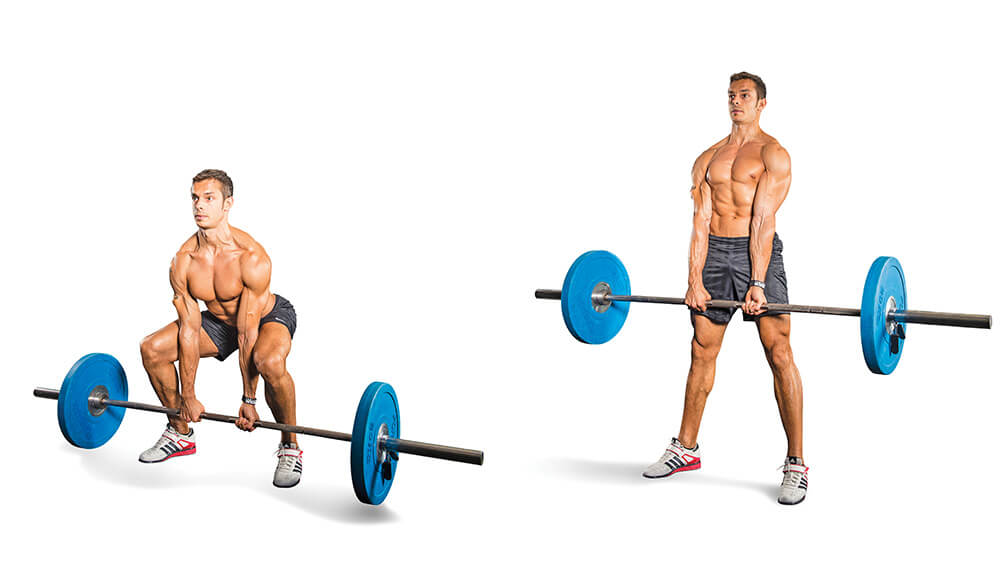
How to: Position your feet outside of shoulder-width apart, and point your toes slightly outward, then move a loaded barbell over your midfoot so that it’s about an inch from your shins. Drop your butt down, letting your knees bend slightly while staying in line with your feet and keeping your back straight. Your shins should be vertical and you should be able to comfortably grip the bar.
Take a deep breath and stand up while dragging the bar up your shins. Reverse the movement to return to the starting position.
Why: The sumo deadlift is a good option if you experience pain or discomfort during the conventional barbell deadlift. This is because it uses a slightly shorter range of motion and allows you to maintain a more vertical back angle, reducing shearing stress on the spine.
[h=2]4. Pull-up[/h]
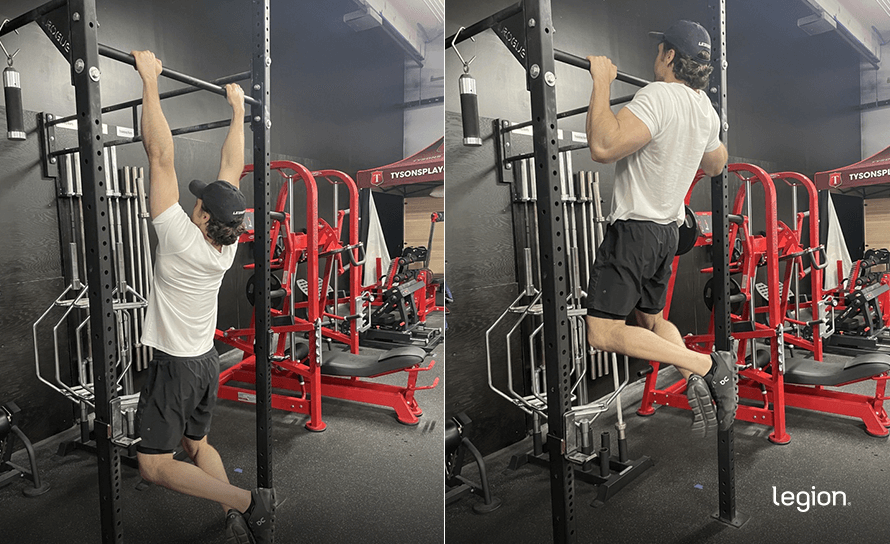
How to: Grip a pull-up bar with your palms facing away from you and slightly wider than shoulder width apart, then lift up your feet so that you’re hanging with your arms straight. Without swinging your feet or your knees, pull your body upward until your chin rises above your hands. After your chin rises above the bar, lower yourself to the starting position. Keep lowering yourself until your arms are completely outstretched and you feel a deep stretch in your lats.
Why: The pull-up trains almost all the muscles of the back, but it’s particularly good at hitting the lats. What’s more, it also trains your biceps, abs, and even your chest muscles to a lesser extent.
[h=2]5. Chin-up[/h]
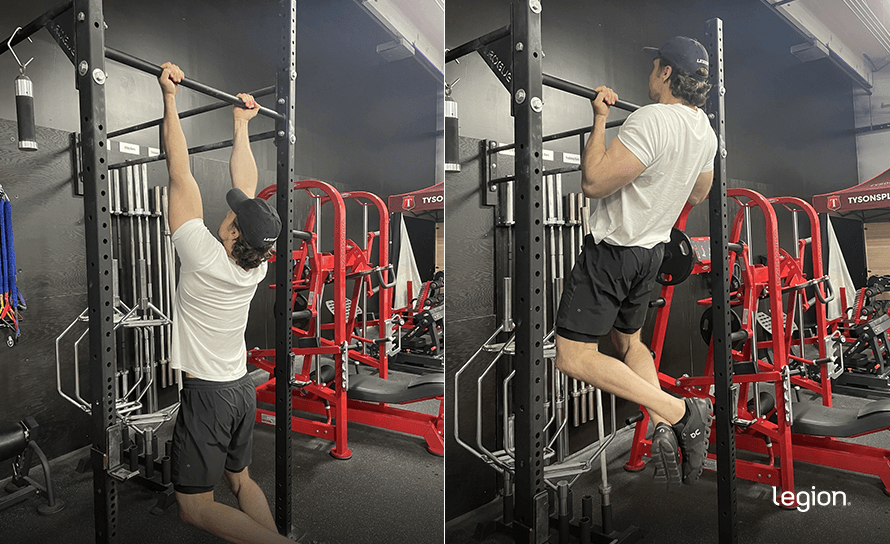
How to: Grip a pull-up bar with your palms facing toward you and shoulder width apart, then lift up your feet so that you’re hanging with your arms straight. Without swinging your feet or your knees, pull your body upward until your chin rises above your hands, and then lower yourself to return to the starting position. Keep lowering yourself until your arms are completely outstretched and you feel a deep stretch in your lats.
Why: Like the pull-up, the chin-up is one of the best lat exercises you can do. The main difference between the two exercises is that the chin-up trains your biceps slightly more than the pull-up, whereas the pull-up trains your lower-traps a little more than the chin-up.
[h=2]6. Lat Pulldown[/h]

How to: Adjust the thigh pad of a lat pulldown machine so that it locks your lower body in place. Stand up and grab the bar. While keeping your grip on the bar and your arms straight, sit down, allowing your body weight to pull the bar down with you. Nudge your thighs under the thigh pads and plant your feet flat on the floor.
Pull the bar toward your chest. Once the bar is underneath your chin (or touches your chest, if you want to make the exercise harder), reverse the movement to return to the starting position. (Tip: a helpful cue for this exercise is to imagine pulling your elbows into the floor).
Why: The lat pulldown is an excellent exercise for training your lats, biceps, and traps, especially for beginners who struggle to do chin-ups and pull-ups.
[h=2]7. Barbell Row[/h]
Initiate the movement by driving through your legs, then, using the momentum generated by your lower body, pull the barbell to your upper body, touching it anywhere between your lower chest and belly button. Once the bar touches your body, reverse the movement to return it to the starting position.
Why: Because you use a bit of leg drive to get the bar moving, you can generally lift more weight with the barbell row than you can with other barbell back exercises. It also means the barbell row is more than just a back exercise—it helps to train your hamstrings and hips slightly, too.
[h=2]8. Dumbbell Row[/h]

How to: Hold a dumbbell in your right hand. Bend over and put your left hand and left knee on a bench, chair, windowsill, etc. that’s about knee height off the ground. Keep your right foot planted on the floor and let your right arm (the one holding the dumbbell) extend toward the floor.
Keeping your back straight, pull the dumbbell upward until it touches your torso. Return the dumbbell to the starting position. Once you’ve completed the desired number of reps, repeat the process with your left arm.
Why: The main benefits of the one-arm dumbbell row are that it trains each side of your body independently and that you use a bench for support. This means you can lift more weight per side than you can when you do barbell rows, leading to more progressive overload (and gains!).
[h=2]9. Pendlay Row[/h]
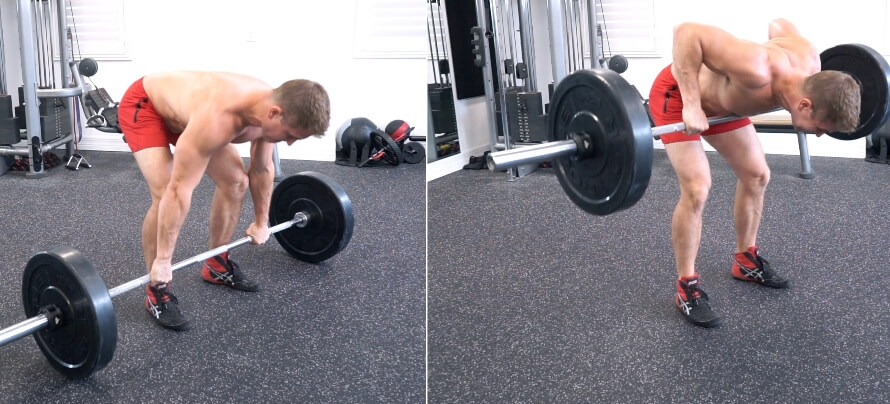
How to: Walk up to a loaded bar and position your feet about shoulder-width apart, with your toes pointed slightly outward. Bend over and grab the bar with a slightly wider than shoulder-width grip with your palms facing toward you. Straighten your back and raise your hips until your back is roughly parallel to the floor.
Pull the barbell to your upper body, touching it anywhere between your lower chest and belly button. Once the bar touches your body, reverse the movement to return it to the floor.
Why: The Pendlay row is similar to the barbell row, except you don’t use your lower body to help hoist the bar off the floor. This means you probably won’t be able to lift as much weight as you do with other row variations, but it also means your lats, traps, and rhomboids do more of the work.
[h=2]10. T-Bar Row[/h]

How to: Place one end of an empty barbell in the corner of a room or rack, or into a landmine attachment, and load the other end with weight plates. Straddle the barbell and hook a close-grip attachment from a cable pulley machine under the weighted end of the barbell.
Grab hold of the handles, straighten your back, and slightly straighten your legs so you’re supporting the weight. Keeping your back mostly stationary, pull the bar toward your chest until the weight plate touches your body. Then reverse the movement to return to the starting position.
Why: Like all barbell back exercises, the T-bar row enables you to lift a lot of weight safely. Since you use a neutral grip (palms facing each other) instead of a pronated grip (palms facing down), it also trains your back muscles in a slightly different way than other row variations.
[h=2]11. Seated Cable Row[/h]
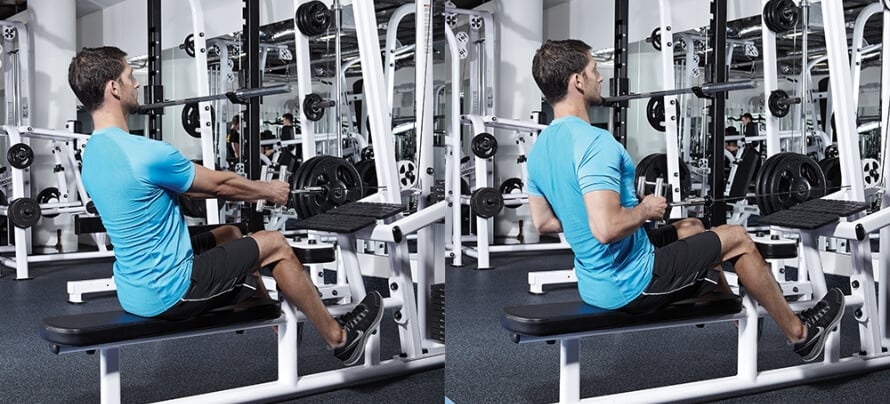
How to: Sit on the pad and place your feet on the foot rest while maintaining a small bend in your knees. Lean forward and grab the handle (you can use whichever handle attachment you want, put I like the close-grip “V” handle), then lean back with your arms stretched in front of you.
Straighten your back and pull the cable toward your stomach. Once your hands touch your torso, reverse the movement to return to the starting position.
Why: The main benefit of the cable row over other row variations is that by using a cable, there’s constant tension on your muscles throughout each rep. This taxes your back muscles slightly differently to other free weight back exercises.
[h=2]12. Standing Lat Pushdown[/h]
Without bending your elbows, pull the rope in an arc toward your feet so that your hands end up at your thighs, then reverse the movement to return to the starting position.
Why: The main benefit of the standing lat pushdown is that it trains your lats in isolation. This is useful because it helps you to “connect” more with your lats, which many people struggle to feel when they do compound back exercises.
[h=2]An Example Back Workout[/h]Heavy, compound back exercises should make up the majority of any well-designed full back workout, which is exactly what you get in the example workout below.
It might seem simple, but trust me—it’s harder than it looks.
Deadlift: 3 sets of 4 to 6 reps
Barbell Row: 3 sets of 4 to 6 reps
One-Arm Dumbbell Row: 3 sets of 8 to 10 reps
Pull-up or chin-up: 3 sets of 8 to 10 reps
If you want more back workouts that include all of the best free weight back exercises you can do, check out this article:
3 Science-Based Back Workouts for More Hypertrophy, Power, and Strength
[h=2]3 Supplements for Better Back Workouts[/h]I saved this for last because it’s the least important.
Unfortunately, no amount of pills and powders are going to give you a muscular back.
In fact, most muscle-building supplements are completely worthless.
But, here’s the good news:
If you know how to train your back properly—using the exercises we just covered—certain supplements can speed up the process.
Here are the best supplements for building a bigger, stronger back:
{feed:enclosure_href }
More...
The post The 12 Best Compound Back Exercises for a Full Back Workout appeared first on Legion Athletics.
Building a great back is freaking hard.
The back is made up of a variety of small, stubborn muscles that often don’t feel like they’re doing much during your back workouts and take their sweet time to grow.
Thus, it’s no wonder that so many people are interested in finding the best back exercises.
Now for the good news: the best back exercises all have a few things in common, and if you do these exercises consistently, you will build a bigger, stronger back in just a few months’ time.
Specifically, you want to focus on what are called compound back exercises.
These are kinds of free weight back exercises that give you a full back workout in less time than other back exercises, and allow you to lift heavier weights more safely.
In this article, you’ll learn the 12 best compound back exercises and my top 3 tips for better back workouts.
- [h=4]Table of Contents[/h]
- The Anatomy of the Back Muscles
- My Top 3 Back Exercise Tips
- Use compound back exercises to train all of your major back muscles.
- Use heavy weights for your back exercises.
- Do 10 to 20 sets for your back per week.
- The 12 Best Back Exercises
- 1. Barbell Deadlift
- 2. Trap-Bar Deadlift
- 3. Sumo Deadlift
- 4. Pull-up
- 5. Chin-up
- 6. Lat Pulldown
- 7. Barbell Row
- 8. Dumbbell Row
- 9. Pendlay Row
- 10. T-Bar Row
- 11. Seated Cable Row
- 12. Standing Lat Pushdown
- An Example Back Workout
- 3 Supplements for Better Back Workouts
[h=2]The Anatomy of the Back Muscles[/h]There are several muscles that make up the bulk of the back:
- Trapezius (traps)
- Rhomboids
- Teres major and minor
- Infraspinatus
- Latissimus dorsi (lats)
- Erector spinae (iliocostalis, longissimus, and spinalis muscles)
Here’s how they look:

Now, if you’re like me, your ultimate goal for your back looks like this:
- Well-developed traps that serve as the centerpiece of the upper back.
- Rhomboids that create clear “valleys” when flexed.
- Wide lats that create the V-taper we all love.
- Highly developed and separated teres muscles and infraspinatus.
- Thick erector spinae that form the base of the “Christmas tree” structure in the lower back.
Success! Your coupon is on the way. Keep an eye on that inbox!
Looks like you're already subscribed!
[h=2]My Top 3 Back Exercise Tips[/h]Before we get into what the best back exercises are, here are a few tips to help you get the most out of your back training.
[h=3]Use compound back exercises to train all of your major back muscles.[/h]Compound exercises are exercises that involve multiple joints and muscle groups at once.
Consequently, they enable you to move more weight than exercises that train just one muscle at a time, and thus are better for progressively overloading your muscles. They also train a variety of muscle groups at once, giving you more muscle-building bang for your buck than other exercises.
The best compound back exercises you can do include exercises like the deadlift, barbell and dumbbell row, and pull-up and chin-up.
[h=3]Use heavy weights for your back exercises.[/h]As a natural weightlifter, your number one goal should be getting stronger.
So long as you make that your primary focus in your training, you’ll have no trouble with building a big back.
What’s the best way to get stronger?
Lift heavy and get progressively stronger.
By “heavy,” I mean doing back exercises with weights in the range of 75 to 85% of your one-rep max (1RM), or in the range of 8 to 10 (~75%) to 4 to 6 (~85%) reps.
You don’t have to do your full back workout in a low rep range—high-rep sets also have a place—but the majority of your time should be spent doing free weight back exercises with heavy weights.
And by “get progressively stronger,” I mean you should be adding weight to the bar (or dumbbells) over time.
[h=3]Do 10 to 20 sets for your back per week.[/h]This is enough for most people to maximize the growth of their back muscles.
You can make progress by doing less than this, but you’re also probably leaving gains on the table. Do more than this, and you might make slightly faster progress, but run a higher risk of burnout and injury.
You can try to fit all of these sets into a single workout per week (a typical body part split), but it’s generally best to spread them across at least two or three workouts. This prevents you from becoming overly fatigued and having to use lighter weights (see tip #2!).
I’ve found that doing one dedicated full back workout and including a few back exercises in other workouts throughout the week (such as chin-ups on arm day) tends to work best.
[h=2]The 12 Best Back Exercises[/h]As we’ve already said, the best exercises for strengthening and developing your back are compound back exercises that allow you to lift heavy weight safely. This is true no matter what your goals are, which is why the best back exercises for men are the same as the best back exercises for women.
[h=2]1. Barbell Deadlift[/h]

How to: Position your feet so they’re slightly narrower than shoulder-width apart with your toes pointed slightly out. Move a loaded barbell over your midfoot so it’s about an inch from your shins.
Take a deep breath into your belly, then move down toward the bar by pushing your hips back. Place your hands on the bar just outside your shins and keep your head in a neutral position. Drive your body upward and slightly back by pushing through your heels. As you approach the lockout, push your hips into the bar.
Reverse the movement to return to the starting position.
Why: The deadlift is hands down the best all-around back exercise you can do because it trains every muscle in your posterior chain (the muscles on the back side of your body). It also allows you to use some of the heaviest weights in any of your workouts, which means it’s ideal for gaining strength and muscle.
[h=2]2. Trap-Bar Deadlift[/h]

How to: Position your feet about shoulder-width apart inside the rectangular center of the trap bar, and adjust your foot position so that when you tug on the bar it moves straight up, not backward or forward. Take a deep breath and flex your abs. Push your hips back, arch your lower back slightly, keep your shoulders back and down, and make sure your head is in a neutral position.
Drive your body upward and slightly back by pushing through your heels. As the bar passes your knees, push your hips forward. Reverse the movement to return to the starting position.
Why: For many people, the trap-bar deadlift is more comfortable and easier to learn than the conventional deadlift. It also allows you to lift around 5 to 10% more weight than you can with the barbell deadlift, and it may be slightly better for improving athletic performance.
[h=2]3. Sumo Deadlift[/h]

How to: Position your feet outside of shoulder-width apart, and point your toes slightly outward, then move a loaded barbell over your midfoot so that it’s about an inch from your shins. Drop your butt down, letting your knees bend slightly while staying in line with your feet and keeping your back straight. Your shins should be vertical and you should be able to comfortably grip the bar.
Take a deep breath and stand up while dragging the bar up your shins. Reverse the movement to return to the starting position.
Why: The sumo deadlift is a good option if you experience pain or discomfort during the conventional barbell deadlift. This is because it uses a slightly shorter range of motion and allows you to maintain a more vertical back angle, reducing shearing stress on the spine.
[h=2]4. Pull-up[/h]

How to: Grip a pull-up bar with your palms facing away from you and slightly wider than shoulder width apart, then lift up your feet so that you’re hanging with your arms straight. Without swinging your feet or your knees, pull your body upward until your chin rises above your hands. After your chin rises above the bar, lower yourself to the starting position. Keep lowering yourself until your arms are completely outstretched and you feel a deep stretch in your lats.
Why: The pull-up trains almost all the muscles of the back, but it’s particularly good at hitting the lats. What’s more, it also trains your biceps, abs, and even your chest muscles to a lesser extent.
[h=2]5. Chin-up[/h]

How to: Grip a pull-up bar with your palms facing toward you and shoulder width apart, then lift up your feet so that you’re hanging with your arms straight. Without swinging your feet or your knees, pull your body upward until your chin rises above your hands, and then lower yourself to return to the starting position. Keep lowering yourself until your arms are completely outstretched and you feel a deep stretch in your lats.
Why: Like the pull-up, the chin-up is one of the best lat exercises you can do. The main difference between the two exercises is that the chin-up trains your biceps slightly more than the pull-up, whereas the pull-up trains your lower-traps a little more than the chin-up.
[h=2]6. Lat Pulldown[/h]

How to: Adjust the thigh pad of a lat pulldown machine so that it locks your lower body in place. Stand up and grab the bar. While keeping your grip on the bar and your arms straight, sit down, allowing your body weight to pull the bar down with you. Nudge your thighs under the thigh pads and plant your feet flat on the floor.
Pull the bar toward your chest. Once the bar is underneath your chin (or touches your chest, if you want to make the exercise harder), reverse the movement to return to the starting position. (Tip: a helpful cue for this exercise is to imagine pulling your elbows into the floor).
Why: The lat pulldown is an excellent exercise for training your lats, biceps, and traps, especially for beginners who struggle to do chin-ups and pull-ups.
[h=2]7. Barbell Row[/h]
How to: Position your feet under a loaded barbell about shoulder-width apart with your toes pointed slightly outward. Bend over and grab the bar with a slightly wider than shoulder-width grip and with your palms facing toward you. Straighten your back and raise your hips until your back is roughly parallel to the floor. Initiate the movement by driving through your legs, then, using the momentum generated by your lower body, pull the barbell to your upper body, touching it anywhere between your lower chest and belly button. Once the bar touches your body, reverse the movement to return it to the starting position.
Why: Because you use a bit of leg drive to get the bar moving, you can generally lift more weight with the barbell row than you can with other barbell back exercises. It also means the barbell row is more than just a back exercise—it helps to train your hamstrings and hips slightly, too.
[h=2]8. Dumbbell Row[/h]

How to: Hold a dumbbell in your right hand. Bend over and put your left hand and left knee on a bench, chair, windowsill, etc. that’s about knee height off the ground. Keep your right foot planted on the floor and let your right arm (the one holding the dumbbell) extend toward the floor.
Keeping your back straight, pull the dumbbell upward until it touches your torso. Return the dumbbell to the starting position. Once you’ve completed the desired number of reps, repeat the process with your left arm.
Why: The main benefits of the one-arm dumbbell row are that it trains each side of your body independently and that you use a bench for support. This means you can lift more weight per side than you can when you do barbell rows, leading to more progressive overload (and gains!).
[h=2]9. Pendlay Row[/h]

How to: Walk up to a loaded bar and position your feet about shoulder-width apart, with your toes pointed slightly outward. Bend over and grab the bar with a slightly wider than shoulder-width grip with your palms facing toward you. Straighten your back and raise your hips until your back is roughly parallel to the floor.
Pull the barbell to your upper body, touching it anywhere between your lower chest and belly button. Once the bar touches your body, reverse the movement to return it to the floor.
Why: The Pendlay row is similar to the barbell row, except you don’t use your lower body to help hoist the bar off the floor. This means you probably won’t be able to lift as much weight as you do with other row variations, but it also means your lats, traps, and rhomboids do more of the work.
[h=2]10. T-Bar Row[/h]

How to: Place one end of an empty barbell in the corner of a room or rack, or into a landmine attachment, and load the other end with weight plates. Straddle the barbell and hook a close-grip attachment from a cable pulley machine under the weighted end of the barbell.
Grab hold of the handles, straighten your back, and slightly straighten your legs so you’re supporting the weight. Keeping your back mostly stationary, pull the bar toward your chest until the weight plate touches your body. Then reverse the movement to return to the starting position.
Why: Like all barbell back exercises, the T-bar row enables you to lift a lot of weight safely. Since you use a neutral grip (palms facing each other) instead of a pronated grip (palms facing down), it also trains your back muscles in a slightly different way than other row variations.
[h=2]11. Seated Cable Row[/h]

How to: Sit on the pad and place your feet on the foot rest while maintaining a small bend in your knees. Lean forward and grab the handle (you can use whichever handle attachment you want, put I like the close-grip “V” handle), then lean back with your arms stretched in front of you.
Straighten your back and pull the cable toward your stomach. Once your hands touch your torso, reverse the movement to return to the starting position.
Why: The main benefit of the cable row over other row variations is that by using a cable, there’s constant tension on your muscles throughout each rep. This taxes your back muscles slightly differently to other free weight back exercises.
[h=2]12. Standing Lat Pushdown[/h]
How to: Set the pulley to the highest position on a cable pulley machine and attach a rope handle. Grip one end of the rope in each hand and take a few steps away from the pulley so that there is tension in the cable. Lean forward so that your body is at about a 45-degree angle relative to the floor. Your arms should be straight and stretched over your head.Without bending your elbows, pull the rope in an arc toward your feet so that your hands end up at your thighs, then reverse the movement to return to the starting position.
Why: The main benefit of the standing lat pushdown is that it trains your lats in isolation. This is useful because it helps you to “connect” more with your lats, which many people struggle to feel when they do compound back exercises.
[h=2]An Example Back Workout[/h]Heavy, compound back exercises should make up the majority of any well-designed full back workout, which is exactly what you get in the example workout below.
It might seem simple, but trust me—it’s harder than it looks.
Deadlift: 3 sets of 4 to 6 reps
Barbell Row: 3 sets of 4 to 6 reps
One-Arm Dumbbell Row: 3 sets of 8 to 10 reps
Pull-up or chin-up: 3 sets of 8 to 10 reps
If you want more back workouts that include all of the best free weight back exercises you can do, check out this article:
3 Science-Based Back Workouts for More Hypertrophy, Power, and Strength
[h=2]3 Supplements for Better Back Workouts[/h]I saved this for last because it’s the least important.
Unfortunately, no amount of pills and powders are going to give you a muscular back.
In fact, most muscle-building supplements are completely worthless.
But, here’s the good news:
If you know how to train your back properly—using the exercises we just covered—certain supplements can speed up the process.
Here are the best supplements for building a bigger, stronger back:
- 3 to 5 grams of creatine per day. This will boost muscle and strength gain, improve anaerobic endurance, and reduce muscle damage and soreness from your back workouts. If you want a 100% natural source of creatine that also includes two other ingredients that will help boost muscle growth and improve recovery, try Recharge.
- Between 0.8 and 1 gram of protein per pound of body weight per day. This provides your body with the “building blocks” it needs to build and repair muscle tissue and help you recover from your workouts. If you want a clean, convenient, and delicious source of protein, try Whey+.
- One serving of Pulse per day. Pulse is a 100% natural pre-workout drink that enhances energy, mood, and focus; increases strength and endurance; and reduces fatigue. You can also get Pulse with caffeine or without.
{feed:enclosure_href }
More...










